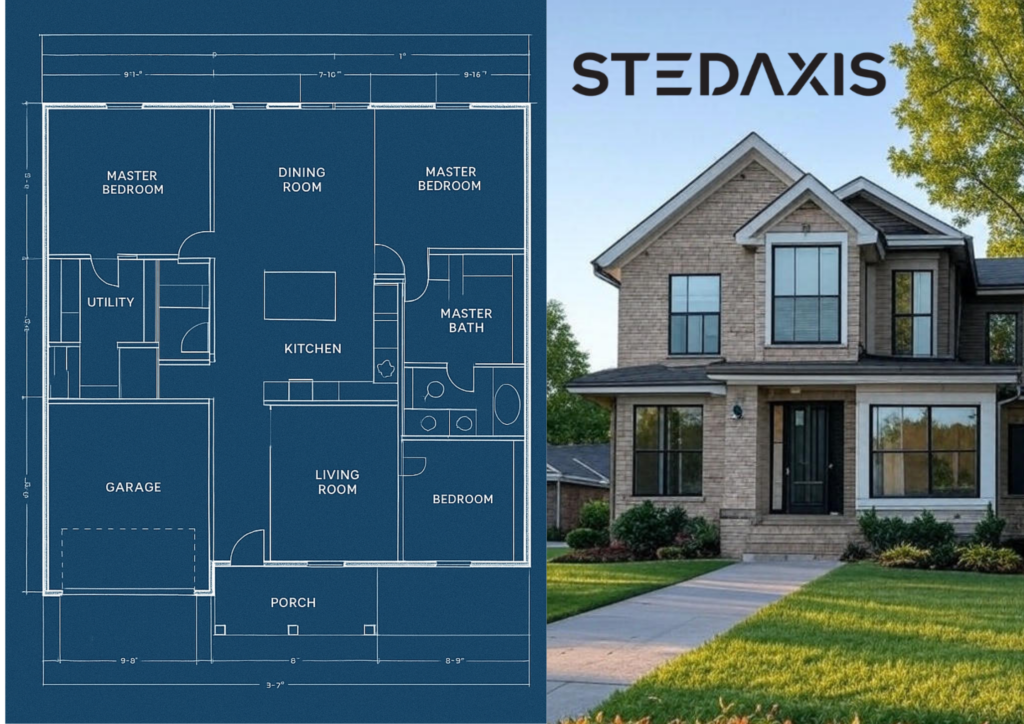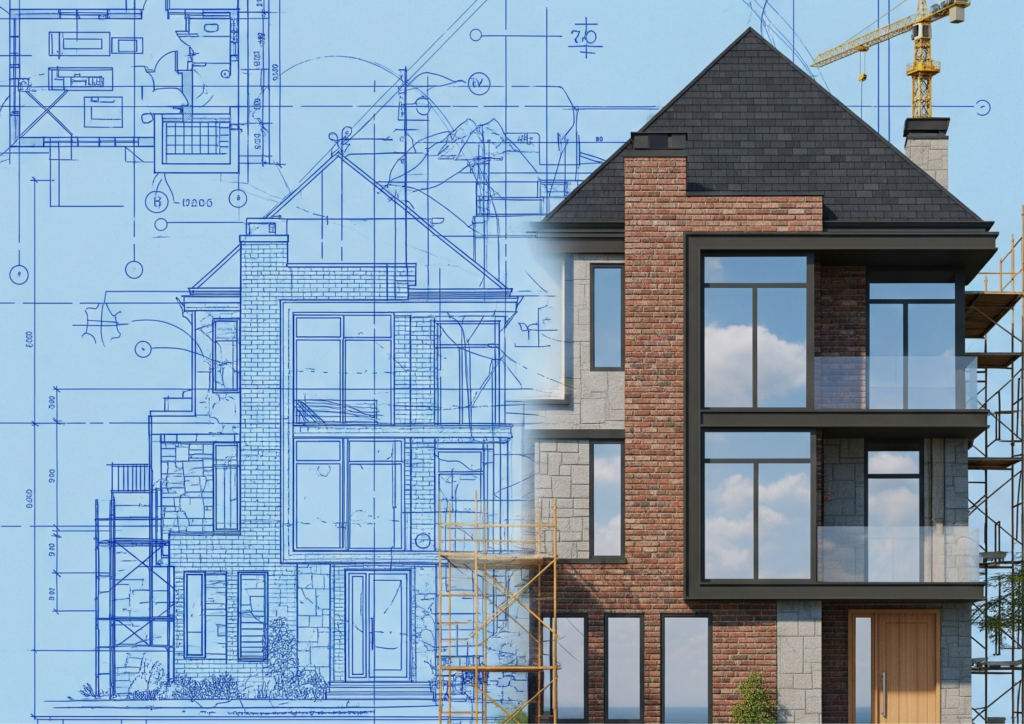
Render in Hours, Not Days: AI-Powered Speed
Faster Approval Timeline
- Without AI Timeline: 24 – 32 weeks from concept to approval
- AI-Enabled Timeline: 12–16 weeks
Narrative-Driven Submissions
- AI-assisted report generation linked to visuals, explaining compliance points clearly.
- Councils can make faster determinations when visual and written justifications align.
- Planners are preferring succinct, image-led submissions over lengthy technical documents.
Measurable Approval Time Reduction
- Combined AI rendering + compliance + context workflow.
- Reduces average DA or CDC assessment times from 2-3 weeks in typical projects.
- Firms using AI in their approval process are reporting 30–50% faster turnaround compared to traditional workflows.
Automated Compliance Checks
- BIM/IFC rule-based validation for setbacks, heights, GFA, and NCC provisions.
- Catch non-compliance before submission, avoiding costly resubmissions or conditions.
- Australian councils and certifiers are moving toward accepting data-linked models alongside plans.
Cost Savings Through Efficiency
- AI-powered 3D rendering can cut approval times by up to 60%
- Reduced risk of cost blowouts by identifying design issues early
- Detailed, accurate renders help secure off-the-plan sales sooner
How AI Will Redefine 3D Rendering
Artificial Intelligence (AI) is poised to revolutionize the 3D rendering industry, reshaping how visual content is created and how quickly it can be produced. AI-driven rendering systems can significantly reduce the time and cost associated with creating high-quality visuals, making it more accessible for a wider range of industries. Below are some ways in which AI is expected to transform the market.
Faster Rendering:
One of the biggest frustrations with traditional rendering is how long it takes to produce a high-quality image.With AI-powered rendering, that wait time shrinks dramatically. Using smart machine learning algorithms, these tools can predict and generate pixel patterns, mimic how light behaves, and even fill in the fine details all in real time. For designers and architects, that means faster turnarounds, more room for creativity, and the ability to explore multiple ideas without being held back by slow rendering times.
Automated Design and Optimization:
AI tools can now take your initial design parameters like dimensions, materials, and performance requirements and automatically produce highly optimised 3D models. This means far less manual modelling and revision work for designers. For industries such as architecture, automotive, and product manufacturing, it’s a huge time-saver: you set the constraints, and the AI explores countless variations to generate the most efficient, functional, and visually appealing design possible
Integration with VR and AR:
AI is set to play a major role in enhancing AR and VR experiences by creating real-time 3D environments that adapt instantly to how users interact. As demand grows for realistic, immersive, and highly responsive virtual spaces, we can expect rapid innovation in AI-driven rendering making these environments feel more lifelike, engaging, and tailored to each user’s actions
Sector-Specific Trends Shaping the Future
Architecture and Real Estate: In the architecture, engineering, and construction (AEC) sector, 3D rendering has become an essential part of the design and development process. It enables architects and designers to produce highly detailed, lifelike models of projects before a single brick is laid. By visualising complex structures in 3D, teams can spot potential issues early, reduce costs, and minimise errors. It also makes collaboration smoother, as stakeholders can see and understand the design from the same perspective. For real estate developers, photorealistic renders are a powerful marketing tool, offering virtual walkthroughs and rich, detailed visuals that help win over buyers and investors.
Automotive and Manufacturing: These industries depend on 3D rendering for everything from product design and prototyping to marketing. High-quality, detailed visuals allow manufacturers to simulate and view products in the development stage, making it easier to refine designs and test functionality well before moving into physical production.
Advertising and Marketing: In advertising, 3D rendering is becoming a go-to tool for creating eye-catching campaigns that truly grab attention. From TV commercials to digital marketing and product demos, these vivid, lifelike visuals help brands tell their story in a way that’s both engaging and memorable.
Healthcare:The healthcare sector is also reaping the benefits of 3D rendering, using it for medical simulations, surgical training, and visualising complex procedures. By creating detailed 3D anatomical models, doctors and educators can improve diagnostics, plan surgeries more effectively, and provide richer, more immersive medical training experiences.
From Sketches to Smart Renders: AI’s Role in Modern Architecture



From Manual Drafting to Digital Rendering:
Early architecture relied on hand-drawn perspectives before CAD and basic 3D tools transformed visualisation.
Photorealism Becomes Standard:
Advances in rendering engines brought lifelike lighting, textures, and materials, making realistic visualisation a client expectation.
Real-Time Rendering Emerges:
Tools like Unreal Engine enabled instant scene updates, speeding up design reviews and presentations.
AI-Driven Design Generation:
Generative AI now produces multiple design options in minutes based on site, code, and environmental constraints.
Intelligent Rendering Optimisation:
AI denoising, material recognition, and automated lighting improve visual quality while reducing render times.
Immersive AR/VR Experiences:
AI enables interactive, real-time environments that adapt to user input for client presentations and council reviews.
Key Benefits of AI-Powered 3D Rendering
- Automates repetitive tasks and the rendering process.
- Frees designers to focus on creativity instead of routine tasks.
- AI learns from a designer’s past work and preferences.
- Suggests design elements and styles aligned with the designer’s unique aesthetic.
- Helps discover new techniques and ideas previously unconsidered.
- Supports immersive 3D environments for detailed exploration.
- Allows viewing designs from every angle in real-time.
- Provides an interactive and realistic experience for architects, interior designers, and product designers.
- Makes presentations more engaging, visually striking, and persuasive.
AI-Powered Instant Rendering, Infinite Possibilities
AI-powered rendering uses advanced machine learning algorithms to simulate lighting, textures, materials, and shadows automatically. Unlike traditional rendering, which can take hours or even days, AI renders images almost instantly without compromising quality.
AI-Powered Rendering Engine: Uses advanced machine learning to generate realistic images quickly.
Multi-Input Support: Accepts 3D models, sketches, photos, or conceptual ideas for rendering.
Smart Lighting & Textures: AI automatically adjusts light, shadows, and materials for photorealistic results.
Style Adaptation: Suggests design styles, materials, and finishes based on your preferences.
Enhanced Accuracy: Realistic lighting, materials, and textures ensure designs look true to life.
Consistent Quality: AI ensures every render maintains high standards and uniformity.
Who Can Benefit from AI-Powered Instant Rendering
Architects: Quickly turn 2D blueprints and 3D models into photorealistic visuals for client presentations.
Urban Planners: Visualize cityscapes, public spaces, and infrastructure projects with realistic lighting, materials, and scale.
Landscape Architects: Simulate outdoor environments, vegetation, and terrain for accurate site planning.
Interior Designers: Experiment with layouts, furniture, finishes, and lighting in real-time to create the perfect ambiance.
Furniture Designers: Render new furniture concepts from sketches or CAD models instantly to showcase to clients or manufacturers.
Home Decor Brands: Create product visuals in different materials, textures, and room settings for marketing campaigns.
Property Developers: Generate realistic renders of apartments, villas, or commercial properties before construction.
Real Estate Agents: Offer virtual tours and marketing visuals to attract potential buyers.
Construction Companies: Share project visuals with stakeholders to simplify approvals and planning.
Product Designers: Transform sketches or CAD models into lifelike renders for prototypes and presentations.
Industrial Designers: Visualize complex machinery, electronics, or consumer products with realistic finishes.
Manufacturers: Use renders for production planning, quality assurance, and marketing collateral.
Advertising Agencies: Create eye-catching visuals, 3D ads, and campaign imagery quickly.
E-commerce Brands: Showcase products in various settings and angles without photography costs.
VR/AR Designers: Render immersive experiences for virtual walkthroughs, simulations, and training programs.
Animation Studios: Produce high-quality visual assets faster with AI assistance.
Ready to Cut Your Approval Times in Half?
At Stedaxis, we know one of the biggest drawbacks of traditional rendering is the time it takes to create high-quality visuals. With our AI-powered rendering technology, that wait is dramatically reduced. By using advanced machine learning, we can predict and generate pixel patterns, accurately simulate light, and fill in missing details all in real time. We help architects, builders, and developers deliver council-ready, AI-powered 3D visualisations that speed up approvals, reduce RFIs, and build stakeholder confidence


